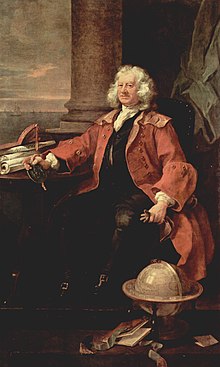Thomas Coram and a Symposium in Greenwich
On 30 October there will be a symposium in London on “Art, Charity & the Navy: The Greenwich & Foundling Hospitals.” This event is hosted and co-sponsored by the Foundling Hospital and Royal Museums Greenwich with its Queen’s House and Old Royal Naval College.
This event will “explore similarities in the origins, artistic involvement and philanthropic purpose of the Foundling Hospital and the Greenwich Royal Hospital for Seamen.” And there’s a Massachusetts connection.
The Foundling Hospital was established in 1739 by Thomas Coram (c. 1668-1751, shown here). Born in Dorset, he went to sea at age eleven. By 1694 he was set up as a shipwright in the part of Taunton soon to be called Dighton. He also apparently had a house, and maybe a shipyard, in Boston, and he certainly worshipped there.
Coram was an Anglican. Most of his Taunton neighbors, like most other New Englanders, were proudly independent of the empire’s established church. In 1703 Coram put 59 acres in trust with the vestry of King’s Chapel in Boston under this condition:
In 1704 Coram returned to England, settling in London. He lobbied Parliament to support the import of tar from North America, which suggests what his own business was. During the early imperial wars, Coram commanded a merchant ship. Afterwards, he promoted settlement in Maine, Georgia, and Nova Scotia. Thomas Coram and his wife Eunice had no children, which freed his fortune for charitable endeavors. Indeed, their surname lives on as a charitable foundation.
As for the Royal Hospital for Seamen at Greenwich, it was set up in 1692 as a marine counterpart to the Chelsea Hospital for old soldiers, receiving a royal charter two years later. The Royal Hospital School was added in 1712. The buildings are a handsome highlight of the Thames waterside.
The speakers at this symposium will include museum officials and curators. The day also includes:
This event will “explore similarities in the origins, artistic involvement and philanthropic purpose of the Foundling Hospital and the Greenwich Royal Hospital for Seamen.” And there’s a Massachusetts connection.
The Foundling Hospital was established in 1739 by Thomas Coram (c. 1668-1751, shown here). Born in Dorset, he went to sea at age eleven. By 1694 he was set up as a shipwright in the part of Taunton soon to be called Dighton. He also apparently had a house, and maybe a shipyard, in Boston, and he certainly worshipped there.
Coram was an Anglican. Most of his Taunton neighbors, like most other New Englanders, were proudly independent of the empire’s established church. In 1703 Coram put 59 acres in trust with the vestry of King’s Chapel in Boston under this condition:
if ever hereafter the inhabitants of the town of Taunton should be more civilized than they now are, and if they should incline to have a Church of England built amongst them, or in their town, then upon application of the inhabitants of said town, that is to say, forty ratable men of them, upon their application, or petition to the said vestry, or their successors, for any suitable part of said land, to build a Church of England, or a school house for the use and service of said church.Taunton didn’t have an Anglican congregation until 1728. And those worshippers didn’t get the benefit of Coram’s grant; the King’s Chapel vestry sold the land for their own church’s benefit in 1754.
In 1704 Coram returned to England, settling in London. He lobbied Parliament to support the import of tar from North America, which suggests what his own business was. During the early imperial wars, Coram commanded a merchant ship. Afterwards, he promoted settlement in Maine, Georgia, and Nova Scotia. Thomas Coram and his wife Eunice had no children, which freed his fortune for charitable endeavors. Indeed, their surname lives on as a charitable foundation.
As for the Royal Hospital for Seamen at Greenwich, it was set up in 1692 as a marine counterpart to the Chelsea Hospital for old soldiers, receiving a royal charter two years later. The Royal Hospital School was added in 1712. The buildings are a handsome highlight of the Thames waterside.
The speakers at this symposium will include museum officials and curators. The day also includes:
- A tour of the Chapel at the Old Royal Naval College, formerly the place of worship for the inhabitants of the Royal Hospital for Seamen
- The opportunity to see the Foundling Museum’s Court Room and Picture Gallery, displaying works of art by Hogarth, Gainsborough, Highmore, Ramsay and many others
- A visit to the Foundling Museum exhibition “Basic Instincts”
- Lunch, tea and coffee, and early evening drinks reception


No comments:
Post a Comment